“I am interested in a political art, that is to say an art of ambiguity, contradiction, uncompleted gestures and uncertain endings.”
There's only one month to go until The Pull of Gravity by acclaimed South African artist William Kentridge opens at YSP on Saturday 28 June!Visit the exhibition from 28 June 2025–19 April 2026.Find out more at  bit.ly/WilliamKentridgeYSPWilliam Kentridge in his studio working on Paper Procession, Johannesburg, 2025. Image courtesy of Kentridge Studio
bit.ly/WilliamKentridgeYSPWilliam Kentridge in his studio working on Paper Procession, Johannesburg, 2025. Image courtesy of Kentridge Studio  Stella Olivier.
Stella Olivier.
“I am interested in a political art, that is to say an art of ambiguity, contradiction, uncompleted gestures and uncertain endings.”
There's only one month to go until The Pull of Gravity by acclaimed South African artist William Kentridge opens at YSP on Saturday 28 June!
Visit the exhibition from 28 June 2025–19 April 2026.
Find out more at  bit.ly/WilliamKentridgeYSP
bit.ly/WilliamKentridgeYSP
William Kentridge in his studio working on Paper Procession, Johannesburg, 2025. Image courtesy of Kentridge Studio  Stella Olivier.
Stella Olivier.
Film projections, animation, opera, painting, sculpture: the South African…
FT.COM
Film projections, animation, opera, painting, sculpture: the South African…
FT.COM
William Kentridge: Listening to the Image -- Neubauer Collegium Inaugural Lecture at the UChicago
~~~
https://en.wikipedia.org/wiki/William_Kentridge
In 2009, Kentridge, in partnership with Gerhard Marx, created a 10m-tall sculpture for his home city of Johannesburg entitled Fire Walker. In 2012 his sculpture,Il cavaliere di Toledo, was unveiled in Naples.[18] Rebus(2013), referring in title to the allusional device using pictures to represent words or parts of words, is a series of bronze sculptures that form two distinct images when turned to a certain angle; when paired in correspondence, for example, a final image – a nude – is created from two original forms – a stamp and a telephone.[19]
An article about Kentridge by Calvin Tomkins appears in the 18 January 2010 issue of The New Yorker.
| William Kentridge | |
|---|---|

| |
| Born | 28 April 1955 (age 61) Johannesburg |
| Education | University of the Witwatersrandand Johannesburg Art Foundation |
| Known for | Printmaking, drawings, andanimated films |
William Kentridge (born 28 April 1955) is a South African artist best known for his prints, drawings, and animated films. These are constructed by filming a drawing, making erasures and changes, and filming it again. He continues this process meticulously, giving each change to the drawing a quarter of a second to two seconds' screen time. A single drawing will be altered and filmed this way until the end of a scene. These palimpsest-like drawings are later displayed along with the films as finished pieces of art.[1]
~~~~






